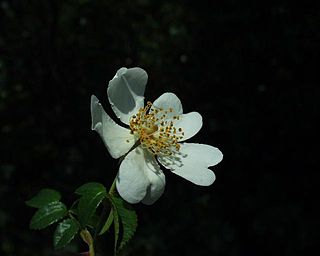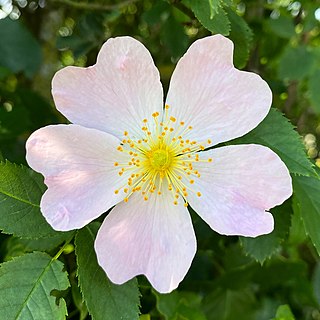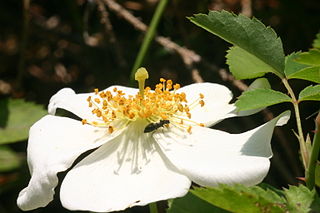
Rosaceae, the rose family, is a medium-sized family of flowering plants that includes 4,828 known species in 91 genera.

A rose is either a woody perennial flowering plant of the genus Rosa, in the family Rosaceae, or the flower it bears. There are over three hundred species and tens of thousands of cultivars. They form a group of plants that can be erect shrubs, climbing, or trailing, with stems that are often armed with sharp prickles. Their flowers vary in size and shape and are usually large and showy, in colours ranging from white through yellows and reds. Most species are native to Asia, with smaller numbers native to Europe, North America, and northwestern Africa. Species, cultivars and hybrids are all widely grown for their beauty and often are fragrant. Roses have acquired cultural significance in many societies. Rose plants range in size from compact, miniature roses, to climbers that can reach seven meters in height. Different species hybridize easily, and this has been used in the development of the wide range of garden roses.

Potentilla is a genus containing over 300 species of annual, biennial and perennial herbaceous flowering plants in the rose family, Rosaceae.

Sorbus is a genus of over 100 species of trees and shrubs in the rose family, Rosaceae. Species of Sorbus (s.l.) are commonly known as whitebeam, rowan (mountain-ash) and service tree. The exact number of species is disputed depending on the circumscription of the genus, and also due to the number of apomictic microspecies, which some treat as distinct species, but others group in a smaller number of variable species. Recent treatments classify Sorbus in a narrower sense to include only the pinnate leaved species of subgenus Sorbus, raising several of the other subgenera to generic rank.

Cercocarpus, commonly known as mountain mahogany, is a small genus of at least nine species of nitrogen-fixing flowering plants in the rose family, Rosaceae. They are native to the western United States and northern Mexico, where they grow in chaparral and semidesert habitats and climates, often at high altitudes. Several are found in the California chaparral and woodlands ecoregion.

Rosa acicularis is a flowering plant in the Rosaceae family. It is commonly known as the prickly wild rose, prickly rose, bristly rose, wild rose or Arctic rose. It is a species of wild rose with a Holarctic distribution in northern regions of Asia, Europe, and North America.

The Islamic State (IS), also known as the Islamic State of Iraq and the Levant, Islamic State of Iraq and Syria, and by its Arabic acronym Da'ish or Daesh, is a transnational militant Islamist terrorist group and former unrecognized quasi-state that follows the Salafi jihadist branch of Sunni Islam. It was founded by Abu Musab al-Zarqawi in 1999 and gained global prominence in 2014, when it captured a large amount of Iraqi territory, and took advantage of the civil war in Syria to take control of chunks of territory in Eastern Syria. By the end of 2015, it held an area estimated to contain eight to twelve million people stretching from western Iraq to eastern Syria, where it enforced its interpretation of Islamic law, administered an annual budget of more than US$1 billion and had more than 30,000 fighters under its command. By 2019 it had lost the last of its Middle Eastern territories and returned to insurgency in the regions it once controlled, operating from remote hideouts, and continuing its propaganda efforts.

Rosa sempervirens, the evergreen rose, is a species of wild rose native to the Mediterranean. It is a climbing perennial with very prickly stems.

Rosa majalis is a species of deciduous shrubs in the genus Rosa, native to forests of Europe and Siberia. It grows to 2 m. and yields edible hip fruits rich in vitamin C, which are used in medicine and to produce rose hip syrup.

Malinae is the name for the apple subtribe in the rose family, Rosaceae. This name is required by the International Code of Nomenclature for algae, fungi, and plants, which came into force in 2011 for any group at the subtribe rank that includes the genus Malus but not either of the genera Rosa or Amygdalus. The group includes a number of plants bearing commercially important fruits, such as apples and pears, while others are cultivated as ornamentals.

Prunus subg. Prunus is a subgenus of Prunus. This subgenus includes plums, apricots and bush cherries. Some species conventionally included in Prunus subg. Amygdalus are clustered with plum/apricot species according to molecular phylogenetic studies. Shi et al. (2013) has incorporated subg. Amygdalus into subg. Prunus, thereby including almonds and peaches in this subgenus. The species in this subgenus have solitary flowers or 2–3 in a fascicle.

Rosa corymbifera, the thicket dog rose, is a species of flowering plant in the family Rosaceae. It is native to northwestern Africa, nearly all of Europe, the Caucasus, the Middle East, and Central Asia. It primarily differs from the dog rose Rosa canina in having downier leaves, particularly on the abaxial surfaces. The most widely used rootstock in Europe for garden roses is its cultivar 'Laxa'.

Rosa arvensis, the field rose, is a species of wild rose native to Western, Central and Southern Europe.

Rosa pendulina,, the Alpine rose or mountain rose, is a species of wild rose found in the mountains of central and southern Europe. It appears to have survived in glacial refugia in the Alps and Carpathians, and spread out from there. A climbing shrub with deep pink flowers and relatively few thorns, it has had a history of cultivation as an ornamental plant.

Rosa tomentosa, otherwise known as the harsh downy-rose, is a species of wild rose. It is a shrub growing to about 3 metres (10 ft). It is found in Asia Minor, the Caucasus, and much of Europe: the British Isles, France, Central Europe, northern Spain, Italy, and the Balkans . On the British Isles it can be found in hedgerows and woodland margins, and it typically flowers between June and July. Further south, in Bulgaria, it flowers in May.

Rosa mollis is a species of wild rose. Common name: soft downy-rose. It is most closely related to Rosa villosa. Rosa mollis can be distinguished from Rosa villosa by its longer leaves and pruinose stem, which is absent in the latter. Rosa mollis usually blossoms in Germany for approximately 5 weeks from the end of June to July
Rosa abrica is a species of rose in the plant family Rosaceae, native to Iran.

Rosa stylosa, the short-styled field rose, is a species of flowering plant in the family Rosaceae, native to western and southern Europe, and northwestern Africa. It has gone extinct in Hungary. It is not readily available from commercial suppliers.

Rosa sherardii, the northern downy rose or Sherard's downy-rose, is a species of flowering plant in the family Rosaceae. A shrub reaching 2 m (7 ft), it is native to cooler parts of Europe, and has been introduced to the US state of Vermont. In the garden it prefers a sheltered location in full sun with moist but well-drained soil. More compact than Rosa tomentosa, its grey-leaved form in particular is considered under-represented in cultivation.

Rosa mandonii is a species of flowering plant in the family Rosaceae, native to Madeira. Some authorities consider it to be indistinguishable from Rosa canina, the dog rose. It is most often found in the laurisilva, but can also occur in other types of woodland and in thickets.



















